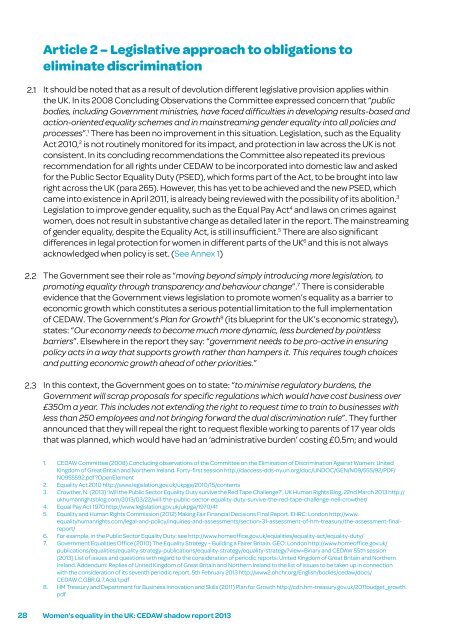Women’s equality in the UK – A health check
Women’s equality in the UK – A health check
Women’s equality in the UK – A health check
Create successful ePaper yourself
Turn your PDF publications into a flip-book with our unique Google optimized e-Paper software.
2.1<br />
2.2<br />
2.3<br />
Article 2 <strong>–</strong> Legislative approach to obligations to<br />
elim<strong>in</strong>ate discrim<strong>in</strong>ation<br />
It should be noted that as a result of devolution different legislative provision applies with<strong>in</strong><br />
<strong>the</strong> <strong>UK</strong>. In its 2008 Conclud<strong>in</strong>g Observations <strong>the</strong> Committee expressed concern that “public<br />
bodies, <strong>in</strong>clud<strong>in</strong>g Government m<strong>in</strong>istries, have faced difficulties <strong>in</strong> develop<strong>in</strong>g results-based and<br />
action-oriented <strong>equality</strong> schemes and <strong>in</strong> ma<strong>in</strong>stream<strong>in</strong>g gender <strong>equality</strong> <strong>in</strong>to all policies and<br />
processes”. 1 There has been no improvement <strong>in</strong> this situation. Legislation, such as <strong>the</strong> Equality<br />
Act 2010, 2 is not rout<strong>in</strong>ely monitored for its impact, and protection <strong>in</strong> law across <strong>the</strong> <strong>UK</strong> is not<br />
consistent. In its conclud<strong>in</strong>g recommendations <strong>the</strong> Committee also repeated its previous<br />
recommendation for all rights under CEDAW to be <strong>in</strong>corporated <strong>in</strong>to domestic law and asked<br />
for <strong>the</strong> Public Sector Equality Duty (PSED), which forms part of <strong>the</strong> Act, to be brought <strong>in</strong>to law<br />
right across <strong>the</strong> <strong>UK</strong> (para 265). However, this has yet to be achieved and <strong>the</strong> new PSED, which<br />
came <strong>in</strong>to existence <strong>in</strong> April 2011, is already be<strong>in</strong>g reviewed with <strong>the</strong> possibility of its abolition. 3<br />
Legislation to improve gender <strong>equality</strong>, such as <strong>the</strong> Equal Pay Act 4 and laws on crimes aga<strong>in</strong>st<br />
women, does not result <strong>in</strong> substantive change as detailed later <strong>in</strong> <strong>the</strong> report. The ma<strong>in</strong>stream<strong>in</strong>g<br />
of gender <strong>equality</strong>, despite <strong>the</strong> Equality Act, is still <strong>in</strong>sufficient. 5 There are also significant<br />
differences <strong>in</strong> legal protection for women <strong>in</strong> different parts of <strong>the</strong> <strong>UK</strong> 6 and this is not always<br />
acknowledged when policy is set. (See Annex 1)<br />
The Government see <strong>the</strong>ir role as “mov<strong>in</strong>g beyond simply <strong>in</strong>troduc<strong>in</strong>g more legislation, to<br />
promot<strong>in</strong>g <strong>equality</strong> through transparency and behaviour change”. 7 There is considerable<br />
evidence that <strong>the</strong> Government views legislation to promote women’s <strong>equality</strong> as a barrier to<br />
economic growth which constitutes a serious potential limitation to <strong>the</strong> full implementation<br />
of CEDAW. The Government’s Plan for Growth 8 (its bluepr<strong>in</strong>t for <strong>the</strong> <strong>UK</strong>’s economic strategy),<br />
states: “Our economy needs to become much more dynamic, less burdened by po<strong>in</strong>tless<br />
barriers”. Elsewhere <strong>in</strong> <strong>the</strong> report <strong>the</strong>y say: “government needs to be pro-active <strong>in</strong> ensur<strong>in</strong>g<br />
policy acts <strong>in</strong> a way that supports growth ra<strong>the</strong>r than hampers it. This requires tough choices<br />
and putt<strong>in</strong>g economic growth ahead of o<strong>the</strong>r priorities.”<br />
In this context, <strong>the</strong> Government goes on to state: “to m<strong>in</strong>imise regulatory burdens, <strong>the</strong><br />
Government will scrap proposals for specific regulations which would have cost bus<strong>in</strong>ess over<br />
£350m a year. This <strong>in</strong>cludes not extend<strong>in</strong>g <strong>the</strong> right to request time to tra<strong>in</strong> to bus<strong>in</strong>esses with<br />
less than 250 employees and not br<strong>in</strong>g<strong>in</strong>g forward <strong>the</strong> dual discrim<strong>in</strong>ation rule”. They fur<strong>the</strong>r<br />
announced that <strong>the</strong>y will repeal <strong>the</strong> right to request flexible work<strong>in</strong>g to parents of 17 year olds<br />
that was planned, which would have had an ‘adm<strong>in</strong>istrative burden’ cost<strong>in</strong>g £0.5m; and would<br />
1. CEDAW Committee (2008) Conclud<strong>in</strong>g observations of <strong>the</strong> Committee on <strong>the</strong> Elim<strong>in</strong>ation of Discrim<strong>in</strong>ation Aga<strong>in</strong>st Women: United<br />
K<strong>in</strong>gdom of Great Brita<strong>in</strong> and Nor<strong>the</strong>rn Ireland. Forty-first session http://daccess-dds-ny.un.org/doc/UNDOC/GEN/N09/555/92/PDF/<br />
N0955592.pdf?OpenElement<br />
2. Equality Act 2010 http://www.legislation.gov.uk/ukpga/2010/15/contents<br />
3. Crow<strong>the</strong>r, N. (2013) ‘Will <strong>the</strong> Public Sector Equality Duty survive <strong>the</strong> Red Tape Challenge?’, <strong>UK</strong> Human Rights Blog, 22nd March 2013 http://<br />
ukhumanrightsblog.com/2013/03/22/will-<strong>the</strong>-public-sector-<strong>equality</strong>-duty-survive-<strong>the</strong>-red-tape-challenge-neil-crow<strong>the</strong>r/<br />
4. Equal Pay Act 1970 http://www.legislation.gov.uk/ukpga/1970/41<br />
5. Equality and Human Rights Commission (2012) Mak<strong>in</strong>g Fair F<strong>in</strong>ancial Decisions F<strong>in</strong>al Report. EHRC: London http://www.<br />
<strong>equality</strong>humanrights.com/legal-and-policy/<strong>in</strong>quiries-and-assessments/section-31-assessment-of-hm-treasury/<strong>the</strong>-assessment-f<strong>in</strong>alreport/<br />
6. For example, <strong>in</strong> <strong>the</strong> Public Sector Equality Duty: see http://www.homeoffice.gov.uk/equalities/<strong>equality</strong>-act/<strong>equality</strong>-duty/<br />
7. Government Equalities Office (2010) The Equality Strategy <strong>–</strong> Build<strong>in</strong>g a Fairer Brita<strong>in</strong>. GEO: London http://www.homeoffice.gov.uk/<br />
publications/equalities/<strong>equality</strong>-strategy-publications/<strong>equality</strong>-strategy/<strong>equality</strong>-strategy?view=B<strong>in</strong>ary and CEDAW 55th session<br />
(2013) List of issues and questions with regard to <strong>the</strong> consideration of periodic reports: United K<strong>in</strong>gdom of Great Brita<strong>in</strong> and Nor<strong>the</strong>rn<br />
Ireland. Addendum: Replies of United K<strong>in</strong>gdom of Great Brita<strong>in</strong> and Nor<strong>the</strong>rn Ireland to <strong>the</strong> list of issues to be taken up <strong>in</strong> connection<br />
with <strong>the</strong> consideration of its seventh periodic report, 5th February 2013 http://www2.ohchr.org/English/bodies/cedaw/docs/<br />
CEDAW.C.GBR.Q.7.Add.1.pdf<br />
8. HM Treasury and Department for Bus<strong>in</strong>ess Innovation and Skills (2011) Plan for Growth http://cdn.hm-treasury.gov.uk/2011budget_growth.<br />
pdf<br />
28 <strong>Women’s</strong> <strong>equality</strong> <strong>in</strong> <strong>the</strong> <strong>UK</strong>: CEDAW shadow report 2013


